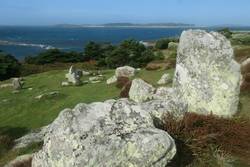Many years ago I came across the Isles of Scilly (albeit indirectly), in Rick Wakeman’s album ‘Myths and Legends of King Arthur and the Knights of the Round Table’, which I bought during my pilgrimage into prog rock in 1979. This featured the land of Lyonesse in one of its narrations and jogged me to find out more. I read the Arthurian cycle and found Lyonesse recorded in the 12th C epic Le Roman de Tristan, as the home Sir Tristan (one of the Knights of the Round Table). So the realm is intrinsically part of the tragic love-and-loss story of Tristan and Iseult. Later on, Lord Tennyson's epic Idylls of the King describes Lyonesse as the site of the final battle between King Arthur and the bad guy of the Dark Ages, Mordred (Arthur's nephew and illegitimate son by his half-sister and malevolent witch Morgause).
How did the Isles of Scilly become identified with this mythical realm of Lyonesse? Knowledge of the existence of the Scillies was widespread in the West Country from an early date (more below) and it is not hard to see how islands known to exist beyond the horizon could be conflated to land or realms in the early Arthurian tales. Some of these originate from Cornwall and so the Scillies could easily become the fabled land across the sea mentioned in them.
In practice the Isles have been known for millennia to people in Cornwall. They are full of archaeological sites from the Neolithic onwards and the traces of habitation from the earliest days are very visible. Tumuli, Iron Age villages, ancient stone ramparts, archaic field walls visible at low tide, all can be seen and explored on the various islands as indeed we saw them on our hikes and perambulations. Analysis of the internal walls of a barrow on St Mary’s show that they were painted red and white. You can only speculate on the ceremonies that must have been held inside.
A major mystery is the Iron Age stone rampart and vallum on Bryher which walls off the far north of the island. Who were the ancient farmers and fishermen of Bryher scared of that would cause them to build this wall? Was this a threat from a tribe or clan or another island, or a threat from mainland? Mysterious also is the recently discovered tomb of Bryher Woman, an Iron Age interment of a high status woman buried with a sword and a mirror. Why the sword? Was this the matriarch of the Island? It is hard to peer behind the curtain of antiquity and understand the minds and values of people so far removed from us.
What always impresses me is the latent ability of ancient people to build and sail boats over long distances. No ships from the time of the prehistoric settlement by people of the Scillies have survived, although we can see rock carvings from Scandinavia which point to their shape and construction. It seems incredible that groups of early farmers pushed their tiny boats out into the Atlantic to find land, taking goats and sheep with them. Such journeys must have been dangerous and uncomfortable, subject always to the whim of the ocean and currents. A startling find in the 1960s was a Romano-British shrine on Nornour with pits containing offerings of brooches. Now just a tiny islet, but two millennia ago a larger island, Nornour would have been the first island a wayfarer from the mainland would have reached by boat. Were the offerings made by travellers to thank the gods for their safe arrival? Interesting subjects for contemplation. I am very thankful that I visited the Isles and that we all had such an interesting time.
John M

